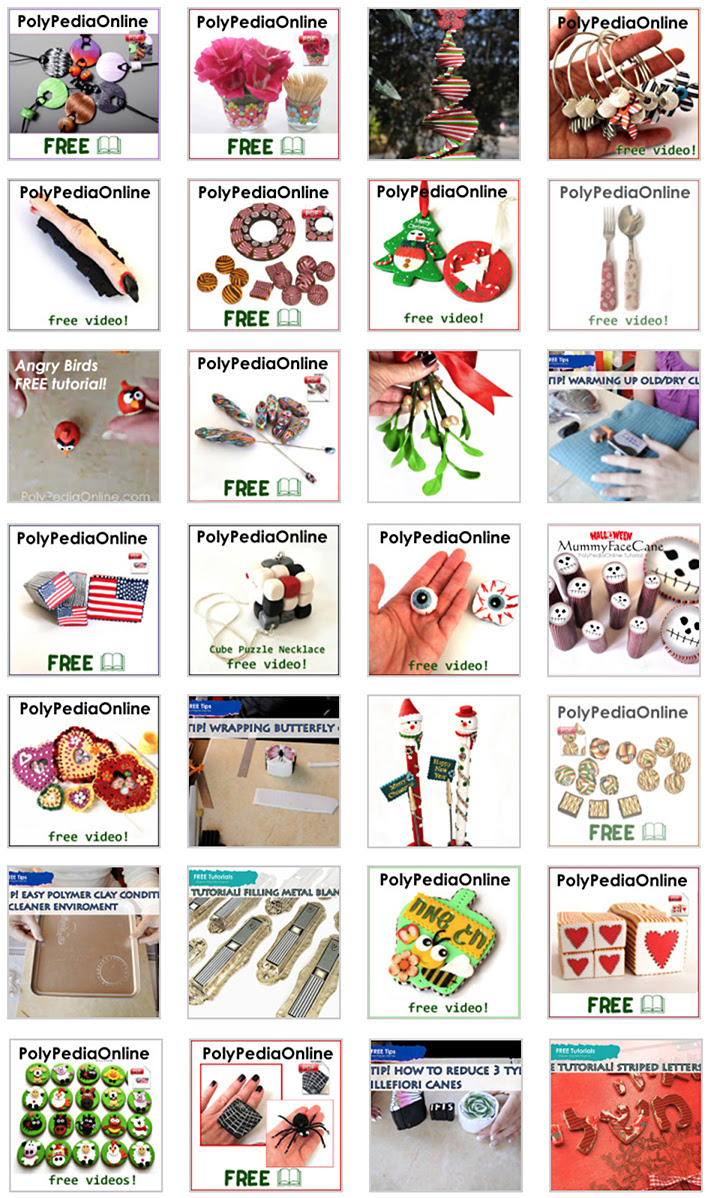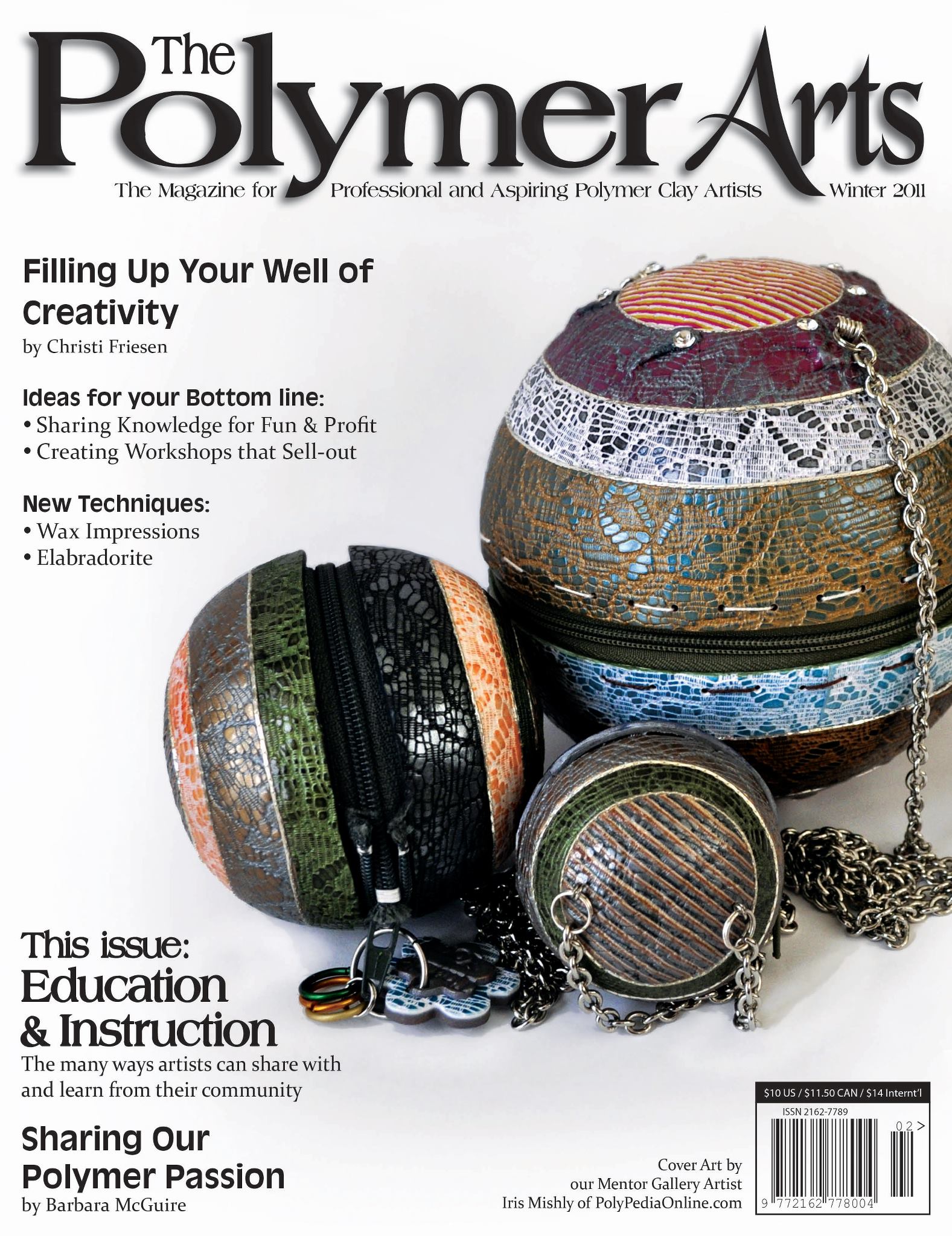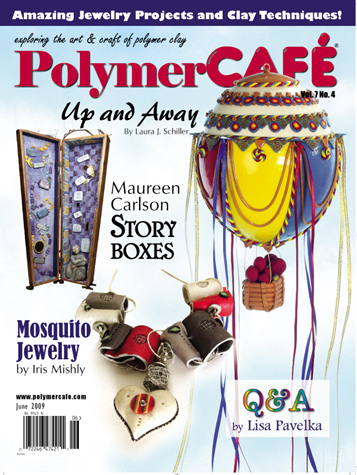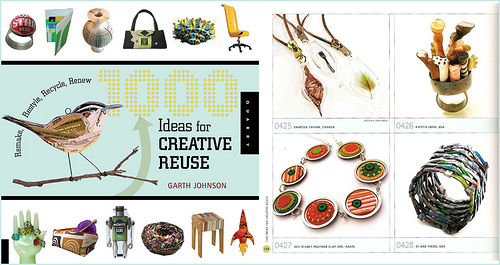Polymeri Online 13.12.06
Polymer_Clay_People - some projects, i wish the site would be a little more alive...
and some GREAT cane tips:
From Liz Mason
Tip: "Display - I have been working with clay about a year and a half. I have made alot of canes, in fact I have so many I can't remember the designs on them. I came up with this solution...I take a picture frame, I prefer one without a picture, I put a white piece of paper under the glass. I then put the frame back together, and hang it above my work station. Now I take a slice of each cane, and gently push it on the top of the glass. It displays all my work. Actually from a distance it looks like a button collection. It is really great and it keeps your canes from unnecessary handling. The clay sticks right on the glass. "
Tip: "Display - I have been working with clay about a year and a half. I have made alot of canes, in fact I have so many I can't remember the designs on them. I came up with this solution...I take a picture frame, I prefer one without a picture, I put a white piece of paper under the glass. I then put the frame back together, and hang it above my work station. Now I take a slice of each cane, and gently push it on the top of the glass. It displays all my work. Actually from a distance it looks like a button collection. It is really great and it keeps your canes from unnecessary handling. The clay sticks right on the glass. "
From Karen Lucas
Tip: "What do you do with those ugly canes? I know that we all make them sometimes. I've been experimenting recently. I flatten the cane, roll it through the pasta machine on the thickest setting, then roll it into a spiral and reduce it. If the base color is black, I trim off one side before I pass it through the pasta machine. If the base color is a light color, I add a thin layer of black before passing it through the pasta machine. I also flatten with a brayer for a looser spiral. The results are something to behold. I call these Kayz Beads."
Tip: "What do you do with those ugly canes? I know that we all make them sometimes. I've been experimenting recently. I flatten the cane, roll it through the pasta machine on the thickest setting, then roll it into a spiral and reduce it. If the base color is black, I trim off one side before I pass it through the pasta machine. If the base color is a light color, I add a thin layer of black before passing it through the pasta machine. I also flatten with a brayer for a looser spiral. The results are something to behold. I call these Kayz Beads."
From Marcie Latham
Tip: "Peacock Canes are enhanced by using small, dark pink to light pink bullseye canes for the spots, and a flattened piece of this cane in the center.I'v also found that when reducing canes and the ends begin to become concave, I go ahead and cut off slices as I reduce, before they become distorted. This keeps the waste to a minimum."
Tip: "Peacock Canes are enhanced by using small, dark pink to light pink bullseye canes for the spots, and a flattened piece of this cane in the center.I'v also found that when reducing canes and the ends begin to become concave, I go ahead and cut off slices as I reduce, before they become distorted. This keeps the waste to a minimum."
From Amber Dawn Goldish
Tip: "I recently purchased some already made canes from Ebay that were dry and crumbly. I intended on using them on my multi dimensional cane work beads. Since the clay was somewhat crumbly I was worried about reducing the detailed canes. Because they started to crack the designs would not be aligned through and through. I was not happy thinking that the gorgeous canes would have to be trashed.But I lucked out. It just so happened that when I went into the next room to complain to my friend about my problem, there was a mini heater blowing hot air out to warm the room, I sat down in front of the small heater and held the clay a safe distance away, In a matter of a few moments, the clay began to soften and I was then able to very slowly roll and push the dry cane into a pliable "snake" I was very happy I discovered this.I had a few pounds of this stuff to work with. Instead of complaining about the condition , or lack there of in the clay I was able to rejoice in my new discovery. I guess the same can be done with a blow dryer or even a heat gun, the idea is to get even heat on all sides and slowly let the clay warm up, that way the inside has time to soften too."
Tip: "I recently purchased some already made canes from Ebay that were dry and crumbly. I intended on using them on my multi dimensional cane work beads. Since the clay was somewhat crumbly I was worried about reducing the detailed canes. Because they started to crack the designs would not be aligned through and through. I was not happy thinking that the gorgeous canes would have to be trashed.But I lucked out. It just so happened that when I went into the next room to complain to my friend about my problem, there was a mini heater blowing hot air out to warm the room, I sat down in front of the small heater and held the clay a safe distance away, In a matter of a few moments, the clay began to soften and I was then able to very slowly roll and push the dry cane into a pliable "snake" I was very happy I discovered this.I had a few pounds of this stuff to work with. Instead of complaining about the condition , or lack there of in the clay I was able to rejoice in my new discovery. I guess the same can be done with a blow dryer or even a heat gun, the idea is to get even heat on all sides and slowly let the clay warm up, that way the inside has time to soften too."
From Candice Mathewson
Tip: "When I'm about to make a cane I put all the clay I'm going to use on a cookie sheet and put it into the oven. I set the oven at a very low temperature. By doing this my clay is soft as butter to mix and VERY easy on my pasta machine. My hands never ache from warming up cold stiff clay!"
Tip: "Many caners will tell you to let your cane "rest" for a time to allow it to reach a uniform temperature. Okay. Yes, this is a good idea and essential to prevent distortion. However, this does NOT mean that the cane must be uniformly COLD. My canes are almost always large When I let one of my 2-3 pound canes cool overnight, what I have in the morning is a large cold cane. Great. Do you know what a pain in the butt it is to reduce something like this? To say the least, it's difficult and time-consuming. Another problem with this method is that when reducing a cold cane the heat from your hands will warm up the outer layers faster and leave the center cool. There goes your uniform-temperature cane! I've reduced many canes this way with less than ideal results. To remedy this problem, I've learned to put all my canes in the oven before reduction. Again, I use a cookie sheet and set the temperature very low. The results are GREAT! I now have the option of reducing a cane right after I've made it or the next day. The cane is uniformly soft and reduction is a breeze. I can't tell you what a difference this has made for my caning (and my attitude - I actually look forward to reducing a cane!).So, when I want warm and soft clay I use my oven and when I want stiff firm clay I put it in the freezer overnight (or a week or longer)."
Tip: "When I'm about to make a cane I put all the clay I'm going to use on a cookie sheet and put it into the oven. I set the oven at a very low temperature. By doing this my clay is soft as butter to mix and VERY easy on my pasta machine. My hands never ache from warming up cold stiff clay!"
Tip: "Many caners will tell you to let your cane "rest" for a time to allow it to reach a uniform temperature. Okay. Yes, this is a good idea and essential to prevent distortion. However, this does NOT mean that the cane must be uniformly COLD. My canes are almost always large When I let one of my 2-3 pound canes cool overnight, what I have in the morning is a large cold cane. Great. Do you know what a pain in the butt it is to reduce something like this? To say the least, it's difficult and time-consuming. Another problem with this method is that when reducing a cold cane the heat from your hands will warm up the outer layers faster and leave the center cool. There goes your uniform-temperature cane! I've reduced many canes this way with less than ideal results. To remedy this problem, I've learned to put all my canes in the oven before reduction. Again, I use a cookie sheet and set the temperature very low. The results are GREAT! I now have the option of reducing a cane right after I've made it or the next day. The cane is uniformly soft and reduction is a breeze. I can't tell you what a difference this has made for my caning (and my attitude - I actually look forward to reducing a cane!).So, when I want warm and soft clay I use my oven and when I want stiff firm clay I put it in the freezer overnight (or a week or longer)."
From Layl McDill
Tip: "To avoid distortions on the ends of a cane when you reduce it, I stick my canes onto ceramic tiles. This caps off the cane so it won't roll over itself. Small canes are easy but bigger ones you have to make sure the cane sticks to the tile really good. I've also heard of using glass- any smooth surface can work. I have a step by step photo description on my web sight at http://www.claysquared.com/."
Tip: "To avoid distortions on the ends of a cane when you reduce it, I stick my canes onto ceramic tiles. This caps off the cane so it won't roll over itself. Small canes are easy but bigger ones you have to make sure the cane sticks to the tile really good. I've also heard of using glass- any smooth surface can work. I have a step by step photo description on my web sight at http://www.claysquared.com/."
From Kellie Robinson
Tip: "I use a haircomb to get even slices of cane. I place the comb teeth on the cane, and gently press down to make an impression. Then I make my slices where each indention is. On one end of my comb the teeth are very close together, great for very thin slices. On the other end they are a little further apart. One of my favorite tools!"
Tip: "I use a haircomb to get even slices of cane. I place the comb teeth on the cane, and gently press down to make an impression. Then I make my slices where each indention is. On one end of my comb the teeth are very close together, great for very thin slices. On the other end they are a little further apart. One of my favorite tools!"
From Lauren H.
Tip: "When you make canes, I find it best to freeze your finished cane and your knife or blade before you cut! Then, the cane will keep its shaped longer as you cut it, or at least until it reaches room temperature. "
Tip: "When you make canes, I find it best to freeze your finished cane and your knife or blade before you cut! Then, the cane will keep its shaped longer as you cut it, or at least until it reaches room temperature. "
























0 comments:
Post a Comment